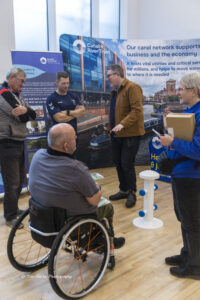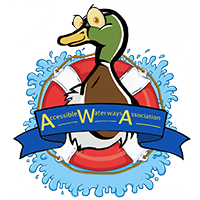Accessible Mooring Bollards
At the Towards Accessible Waterways Day in December, Dick Vincent of Canal and River Trust introduced a prototype of the new accessible mooring bollards. This has been created in response to discussions on the Disabled Boaters’ Forum over many months. Whilst it is acknowledged that there is no “one size fits all”, this bollard addresses most of the issues faced by many boaters with mobility challenges.
The prototype was made from 3D printed pieces and some cleverly adapted sections of standard plumbing pipes. The real thing, of course, would be much more sturdy, but this model was an excellent demonstration of the size, proportions and design.
It is approximately 600cm / 2′ (just above knee-height) to the average adult, and has a slightly domed round top and two pairs of horizontal pegs spaced toward the top of the post. It will be painted in distinctive bright yellow and blue with the words ‘Accessible Mooring’ embossed around the base. The design is intended to be helpful to anyone who has difficulty bending to ground level to moor to ring or standard low-level bollards.
It was developed after much discussion with boaters who have limited mobility and would benefit enormously from the ability to ‘lasso’ these bollards from the deck of their boat. They would then be able to use this to pull their boat in to the bank, deploy a ramp, if needed, to disembark and complete the mooring process.
Being tall and boldly coloured bright yellow and blue (hues proven to be the most visible against natural backgrounds), this design will be much less of a trip hazard to everybody, and will make boating a lot safer, easier and actually more doable for many disabled boaters.
Of course, the bollards would have to be installed very firmly on a deep foundation into the ground in order to counter the extra leverage force that will be applied at a higher level. This needs to be factored into the final design, which has been developed by Marcus Chaloner, CRT’s Head of Placemaking and Design.
The intention is to take the prototype accessible mooring bollard design ‘on tour’ to different events around the country during the spring and summer to gather more feedback before the design is finalised. There is currently no funding allocated to make an install any of the accessible mooring bollards, but once the design is finalised, the plan is to secure external funding for the project.

The prototype bollard provoked a lot of very encouraging conversation at the Towards Accessible Waterways Day.
The general consensus of opinion was that the concept is very much welcomed. We all look forward to the rolling out of the real thing as and when the Trust can secure funding etc for the installation of Accessible Moorings at strategic sites around the network. These will be specifically signed as designated accessible moorings and will give priority to bearers of the Boaters’ Blue Card.
There is a design spec under development for the whole area of these moorings. This will include the careful spacing of the bollards to cater for most lengths and designs of boat, including access to the deck(s). It will also recommend a specified minimum length and breadth of towpath which will be suitably surfaced.
Suggestions for appropriate locations for these are invited by Matthew Symonds, National Boating Manager. If you have any proposed sites, please email matthew.symonds@canalrivertrust.org.uk.
The prototype model of the bollards will be on display at both Boatlife Exhibition at Birmingham’s NEC in mid-February, and at Crick Boat Show over the late May Bank Holiday weekend. If you are visiting either of these events, then please pop along to the CRT stand to view it, and to the AWA stand to chat about it.

waste of Money and a good place to put rubbish, the odd bike frame and dog poo bags